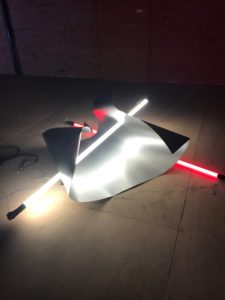Art, ‘Queer Potentiality,’ and the North
By Catherine Murton Stoehr
Above the Belt, Below the Bush will be showing down the laneway to the right of 123 McIntyre St. W, North Bay, On., until Saturday September 29

NORTH BAY— Alexander Rondeau grew up on a farm in New Liskeard. The land was littered with scraps of wood from previous owners. As a child, he watched beavers take the pieces to make a dam, and it put Rondeau in mind of what he calls “Queer potentiality.” I didn’t understand how that story related to the art opening he was hosting, which was about the relationship between queerness, hyper-masculine culture sometimes celebrated in northern communities, and glitter (and all materials favoured by ladies and LGBTQ2S+ folks).
Rondeau explained that because they are not always welcomed into mainstream places, Queer folks make community where they can, sometimes with the materials, and in the places that other folks don’t see or value. Just like the beavers.
Also, as the name of the exhibit suggests, Rondeau likes a naughty pun.
“Above the Belt, Below the Bush” refers to North Bay’s location, above more populated areas to the south but not north enough for real wilderness. Co-curators Rondeau and Robin Alex McDonald solicited works from several artists for the show. In keeping with their appreciation of unloved spaces, the curators chose a disused downtown loft overlooking Lake Nipissing to house the works.
The show featured two Indigenous artists, Dayna Danger, Métis/Saulteaux/Polish from Tio’tia:ke (Montreal), and Walter Kahero:ton Scott, a Kahnawake-born contemporary artist based in Toronto and Montreal. Danger’s art focusses on sexuality and colonialism, and Kahero:ton drew on cartooning practices to create his pieces.
Danger, who works in many mediums, shared two pieces. To Parmeet with Love and To Myself with Love both featured leather harnesses, of a kind used in bondage, hanging from a rack of antlers. The antlers themselves are secured on large boards leaning against the wall. A statement on her blog states that Danger’s “use of BDSM and beading leather fetish masks explores the complicated dynamics of sexuality, gender, and power in a consensual and feminist manner.”
Kahero:ton Scott, who has taught cartooning at Kahnawake, is known for an ongoing series he writes about a character named Wendy, that pokes fun at artists in Montreal. For the North Bay show, he submitted a highly textile wall hanging picturing an upturned bottle with a black background on one side next tot and rueful face on a camo background.
Non-Indigenous artists also submitted works that touched on issues important to Indigenous communities.

Dominic Pinney’s sculpture of bent sheet metal, bisected and bordered by illuminated red and white fluorescent light tubes brought home the danger of road travel in the north. The artist told the story of experiencing a frightening car accident.
Pinney explained that coming from Alberta he had always enjoyed driving long distances across rural land at night and seeing the landscape illuminated by the car’s headlights. After the accident, his desire to keep driving conflicted with his awareness of his own fragility, as the lights in his sculpture appear were vulnerable to the sharp metal pieces around them. He noted the prevalence of road tragedies in Northern Ontario, a phenomenon worsened by minimal transportation alternatives.
Jordyn Stewart from Niagara offered a projection that poked gentle fun at fishing and hunting gear marketed to women. She showed a woman carefully adjusting her hair in a pink camo scrunchie, a bobbing pink fishing lure and her own special creation of a set of fishing waders with extra buckles and ornamentation. She pointed out that however popular pink camo might be, it is ironic that it does not serve the purpose, being rather easier than other colours to spot in the bush.

Two glitter covered hockey sticks leaning against the wall also picked up on the theme of feminine-associated materials. The artist, Tyler Matteson of Sault St. Marie, recounted that an art instructor responded to his art with the question, “Why don’t you be more gay?” Raised in a family of hockey and hunting fans, Matteson said he had never had much room for being gay, much less “more gay.” He hopes maybe a little gay boy playing minor league might see the glittery hockey sticks and be encouraged. In his essay about the exhibit, co-curator Alexander Rondeau said that the hockey sticks “resonated so deeply with me as someone who grew up playing hockey and ultimately quit due to my extreme discomfort as a queer person within hyper masculine hockey culture.”
The theme of hockey was picked up by Hamilton-based artist Adrienne Crossman. Crossman displayed a small gold hockey jersey with the words “No Future” on a bright orange plinth. She explained that in some queer communities, folks not intending to have children turn their attention more fully on the present. The words also connote messages sent to northern and rural young people who are often told that there is no future for them in their home communities.
Co-curator Robin Alex McDonald provided an essay about the show. They ended it with the hope that the exhibit can “serve as a reminder that many of acts, relations, and gestures now understood as ‘queer’ have always existed in the north. Although they have been rendered invisible through settler colonial constructions of ‘heterosexuality,’ they have not been erased.”


